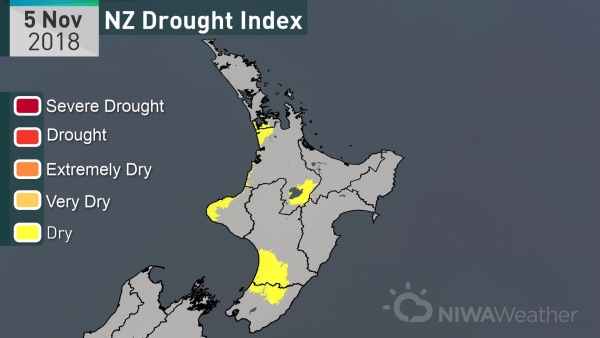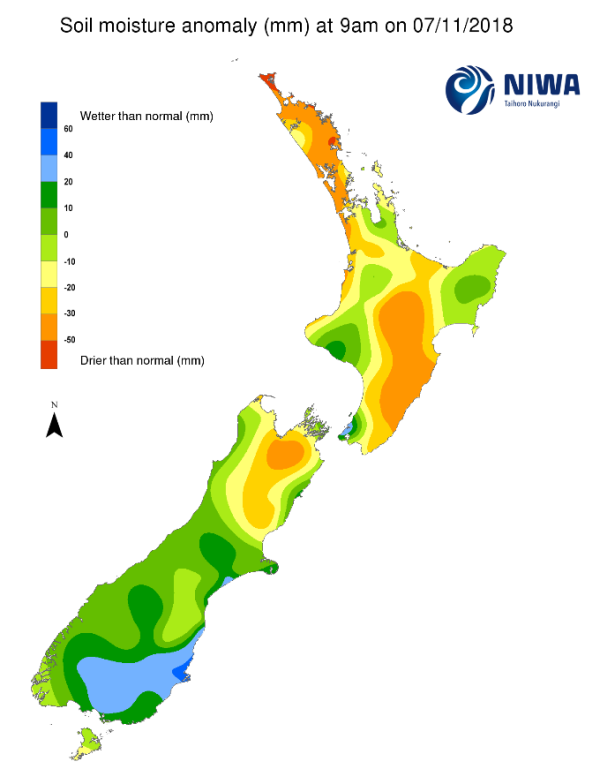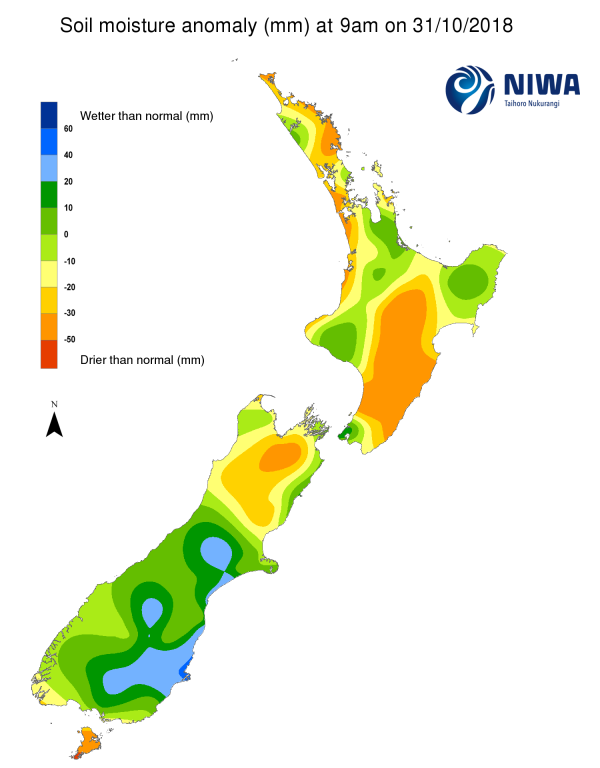A weekly update describing soil moisture across the country to help assess whether severely to extremely dry conditions are occurring or imminent. Regions experiencing these soil moisture deficits are deemed “hotspots”. Persistent hotspot regions have the potential to develop into drought.
Facts: Soil Moisture
Across the North Island, soil moisture levels generally did not change significantly in the past week. Slight improvements were observed in coastal Manawatu-Whanganui and western Wellington, along with small portions of Gisborne and western Waikato. However, decreases in soil moisture levels occurred in Wairarapa, along with small areas of Auckland and most of Northland. The driest soils across the North Island compared to normal for this time of the year are found on the Aupouri Peninsula, while the wettest soils for this time of the year are located along the Kapiti Coast.
The largest hotspot in the North Island continues to be found in Napier and southern Hastings District. A new, very small hotspot has also emerged this week near Cape Reinga.
The New Zealand Drought Index (NZDI) map below shows a few discrete dry areas across the North Island as of 5 November. With generally low rainfall expected over the next week, these areas could increase in size. Please note: the hotspots near Napier and Cape Reinga do not yet appear on the NZDI map, mainly because the NZDI uses additional dryness indices including one which integrates the rainfall deficit over the past 60 days. Changes are therefore slower to appear in the NZDI compared to the instantaneous status maps of soil moisture anomaly.
Across the South Island, soil moisture levels showed some improvement along the West Coast, coastal Tasman, Southland, and Stewart Island. Slight improvements were also observed near Kaikoura. Slight decreases in soil moisture levels occurred in interior Tasman and Hurunui, however. The driest soils across the South Island compared to normal for this time of the year are found in interior Marlborough, while the wettest soils for this time of the year are found in coastal Dunedin.
Despite dry soils in northeastern Marlborough, this area does not meet the requirements to be declared a hotspot. No hotspots are currently in place in the South Island.
Outlook and Soil Moisture
In the North Island, rainfall is expected to be fairly sparse during the upcoming week. Departing high pressure will be in control through Thursday (8th November), with only isolated showers possible. Friday afternoon and Friday night will feature moderate rainfall for western and northern areas, with 5-15 mm accumulations for many locations. However, in the eastern North Island amounts will remain below 5 mm. Beginning on Sunday (11th November), a broad area of high pressure will arrive over the North Island and remain in place through the rest of the week. A few isolated showers may occur in central and eastern areas during this time, but additional rainfall amounts will generally be meagre.
With most of the North Island expected to receive 15 mm of rain or less in the next week, additional decreases in soil moisture levels are anticipated in many areas. As the eastern North Island is expected to see especially low rainfall, the current hotspot in Napier and Hastings is likely to increase in size, and perhaps push farther south toward Wairarapa. In addition, the small hotspot near Cape Reinga will likely expand across more of the Aupouri Peninsula and perhaps parts of the Far North as well.
In the South Island, the rainfall expectations are markedly different than the North Island during the next week. A front will bring very heavy rain to much of the South Island on Thursday and Friday (8-9 November). Widespread amounts up to 100-150 mm are likely in West Coast areas, with perhaps up to 300 mm at higher elevations. These amounts will likely result in flooding issues for the West Coast late this week. Meanwhile, rainfall amounts up to 50 mm could be seen in Southland and Otago, with 50-75 mm for the rest of the eastern South Island. Thereafter, mostly dry weather will arrive for the upcoming weekend. A much weaker front could deliver a few more millimetres of rain on Monday and Tuesday (12-13 November).
Although flooding is likely in the West Coast due to the upcoming heavy rainfall, this will also mean significant increases in soil moisture levels across much of the South Island during the next week. Wetter than normal soils could become widespread in the lower half of the island and the West Coast, with improvements also likely in the upper South Island. No hotspots are expected to form in the next week, and the dry soils in parts of Marlborough will likely show improvements.
Background:
Hotspot Watch a weekly advisory service for New Zealand media. It provides soil moisture and precipitation measurements around the country to help assess whether extremely dry conditions are imminent.
Soil moisture deficit: the amount of water needed to bring the soil moisture content back to field capacity, which is the maximum amount of water the soil can hold.
Soil moisture anomaly: the difference between the historical normal soil moisture deficit (or surplus) for a given time of year and actual soil moisture deficits.
Definitions: “Extremely” and “severely” dry soils are based on a combination of the current soil moisture status and the difference from normal soil moisture. Refer to soil moisture maps for more information.



